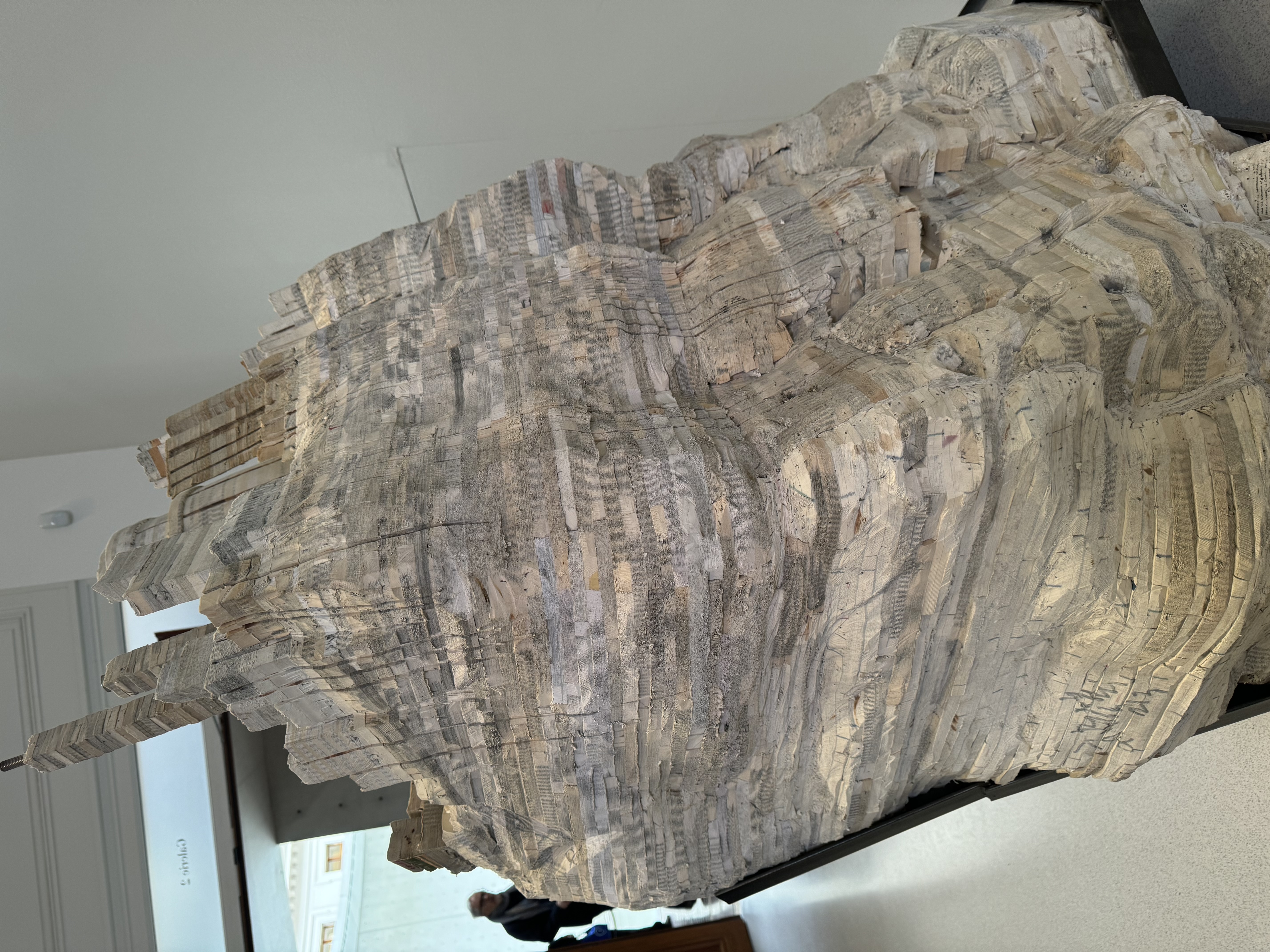
April was such a busy month: I spent most of my days in the company of others, and when I had potential reading time, I was often too tired from walking or hiking and didn’t manage many pages before I fell asleep! But on trains (from Paris to Toulon, from Rome to Lyon, from Lyon to Paris); ferries (Toulon to Porto Torres and Cagliari to Civitavecchia); in the car driving from Tirana to Himare and back; and, finally, the plane back home (from Paris to Vancouver), I read a few books that I enjoyed very much. You might also, if you haven’t already read them. And perhaps when you’ve looked over my book list, you have a few titles to recommend in return.
Before I set out my reading journal notes for last month, let me share the interpretive plaque accompanying Liu Wei’s work Library III, 2012, part of the Pinault Collection at Paris’s La Bourse du Commerce. I saw this last Spring when I was at La Bourse to see Kimsooja’s dizzying upending of that gorgeous space. I’m writing about that exhibition at the moment for this Sunday’s Substack post, and realized that I haven’t yet shared these photos in a bookpost yet, although it’s a year since I took them for exactly that purpose! I’m always interested in art to do with books and reading. (I took many more photos of this work, and if you’re interested, I will post more over on my Instagram account).

Now on to April’s books. . .
I say this every book post now, for those who are new here and as a reminder to regular readers: As usual, the numbering comes from my annual handwritten reading journal, and the italicized text below is directly transcribed from that journal’s pages (once upon a time, I simply included photographs of those pages, but too many of you found my handwriting tough to decipher, especially in the photographed format). Notes to myself, that is, so that I can remember a book and remember my response to it, rather than any attempt at a more polished, edited review.
I’ve used regular font for any additions to my journal notes and included references to any posts from my Instagram Reading account.

18. Garden of Evening Mists. Tan Twan Eng. Literary fiction; historical fiction; Malaysia; Malaysian history; war crimes, Japanese gardens; tattoos; memory.
Another beautifully written, evidently well-researched novel by Tan Twan Eng. This one tells of a newly retired Malaysian judge who has spent much of her career trying those charged with war crimes. She has a personal stake as the only survivor of a Japanese prisoner-of-war camp. Having returned, in her retirement, to the Cameron Highlands, Teoh Yun-Ling is determined to restore the Japanese garden she built under the guidance of the Japanese master gardener who had once worked for the Emperor of Japan. Despite her hatred of all that is Japanese, Yun Ling had asked gardener Aritomo to help her construct a garden in memory of her sister (who perished in the prisoner-of-war camp), who loved the gardens of Kyoto.
As she first constructed that garden, decades earlier, under Aritomo’s tutelage, their relationship grew alongside. Restoring it now, her memory beginning to fail due to a neurological disorder, Yun Ling begins to write what she remembers. Besides the horrific truths of war (and of ongoing violence through the ensuing years in subsequent rebellions and anti-colonial movements) there are also memories of romance, of love, a mystery unfolded, fascinating descriptions of Japanese art, archery, and, especially, tattoos. And of course, gardens and the philosophy they represent.
19. Il Nuovo Venuto. Marco Vicchi. Giallo/mystery novel; Police procedural; Commissario Bordelli series; Set in mid-60s Florence and rural Sardinia; historical fiction; World War II; 60s.
I read this in Italian (to ramp up my language skills while travelling in Italy), but it’s available in an English translation (by Stephen Sartarelli) as Death in Sardinia. I chose it because I was looking for something set in Sardinia where we spent a week hiking. Actually, it features Commissario Bordelli who lives and works in 1960s Florence and, at Christmas time, is investigating the murder of a nasty loanshark whose death Bordelli doesn’t regret.
But meanwhile, one of Bordelli’s best men has gone back to his native Sardinia to heal from gunshot wounds sustained in an arrest. And this young detective, ensconced in his parents’ home, missing his girlfriend, restless and impatient to be mobile again, finds a suspicious death to investigate as well.
A longer mystery than I’d planned to read in Italian, but so much history delivered along with the mystery. Bordelli fought against fascism in WW II, has many traumatic memories — but now he often feels that the newer generation doesn’t care to know about Italy’s past and considers him old and irrelevant. An engaging blend of detection, ethics, world-building (the settings of 60s Sardinia and Florence), complex characterization and social critique.
The novel became even more interesting to me during last week’s Italian class when we looked at some examples of Italian television from the late 50s and early 60s, and I could appreciate even better, retrospectively, the significance of the novel’s many descriptions of characters watching specific programs — whether individually or communally. The introduction of this technology obviously had a huge effect on social cohesion in Italy, and that effect is seen in Bordelli’s sense that his war experiences are becoming irrelevant, especially to those listening to new music from other places.
20. The Cyclist. Tim Sullivan. Mystery/crime novel; Police Procedural; Detective George Cross series; Autistic detective; Set in Bristol, England.
Another in the George Cross series that Wendy (of York) introduced me to, and I enjoyed watching the characters develop in the second volume. As George’s partner has got to know him, she’s been motivated to do some research on autism and as she’s learned that his behaviour isn’t intended to be rude, she’s begun guiding him to more appropriate social interactions. Very interesting to watch the ripple effects of this, to see George’s sharp intelligence applied to analyzing his own behaviour and considering the benefits of changing it (judiciously, and with the best discernment he can manage).
21. Still Life. Louise Penny. Mystery/crime novel; police procedural; Chief Inspector Gamache series; Eastern Townships, Quebec; Art; Community; Archery.
For whatever long-forgotten reason, I was turned off this series almost at its outset and have only ever — I think — read one. I say “I think” because I thought I’d read the first and then stopped, but if I ever read Still Life I had no sense of that as I read it last month — and I enjoyed it so much that I’m surprised my 40-ish self wouldn’t have liked it as well.
Many interesting characters — and of a variety of ages. A focus on art that I found engaging. A detective, Chief Inspector Gamache who’s likeable and seems wise, kind, yet firm when he needs to be. A compelling quandary with a young trainee detective. Oh, and for the second time in my April reading, a focus on archery. Quelle coincidence!
I already have the second in the series on Hold . . .
And, of course, most of you have long since read your way through the series and are ready for her latest, and then her next. The kind of series that readers are quickly addicted to!

That’s it for April’s reading. My list for May is already longer, even though we’re not even halfway through the month. That’s thanks to my having been grounded, since I got home, by a nasty cold and prolonged cough and fatigue. Also thanks to our public library, which had five Holds ready for me within my first week back! I’ve been reading up a storm, and if you have as well (or if you’ve just savoured one or two wonderful books), we’d all be grateful if you’d share in the comments below.
And if you’re curious about my other writing over at Substack, here’s the link for finding me there.
xo,
f
I just finished reading my first Tim Sullivan book ‘The Teacher’. I loved the George Cross character immensely. As a now retired teacher it brought back memories of students who were also on the spectrum. I have been unsuccessful in my search to purchase Sullivan’s earlier Cross novels, but would love to get my hands on them! Ronda
Author
I haven’t read that one yet, Ronda, but look forward to working my way through the series. In Canada, at least, they seem to be available at a number of independent booksellers as well as at Chapters Indigo; as well, they’re available as Kobo e-books. I was surprised to find that they’re not available at my (very good) public library, but I’ve noticed a copy or two at secondhand bookstores. Hope you can track some down.